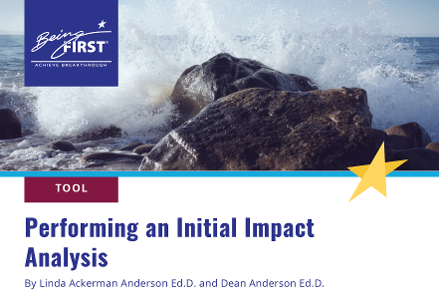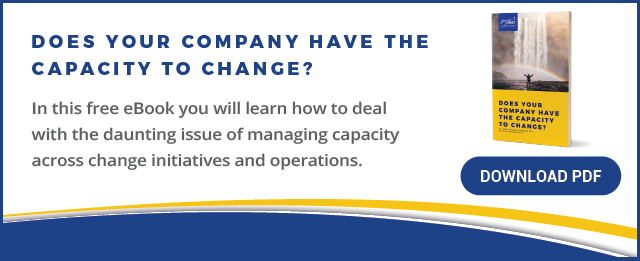We define scope of change for an organization as what must change—how broad and how deep in the organization—and who must make this change. A scope statement should include a clear definition of the various change initiatives within the effort as well as the people and groups that must be involved. For transformation to work, scope must attend to all the change required.
It must articulate:
1. The organizational and technical work required to generate a new reality or solution.
2. The cultural and people changes required for adoption and sustainment. Essential in your initial scope is understanding that people will need to think, feel, relate, and work differently for the solution to succeed.
Misdiagnosing Scope
One of the most common mistakes leaders make in leading change is to misdiagnose its scope, typically making it too narrow. If it is too limited, repercussions such as scope creep will occur outside of your view of things, creating all kinds of unpleasant surprises. If your scope is not accurate, you may be missing key leverage points for getting the change to happen or expending energy on the wrong things.
Typically, executives think solely about the organizational or technical changes, such as a new structure or business process, or a new technological solution. While these are central to what must change, they don’t address the impacts on people, cultural norms, leadership requirements, and even mindsets and behaviors. These are the elements that cause the slowdown, if not actual impairment, of success. They are a legitimate part of scope management, and require expertise, support, resources, and time to address adequately. They are key to why so many change initiatives do not get the adoption and sustainment they need. As many have said, “having the solution is not the solution.” This means if we can’t get people to do the change, the best of solutions is worthless! All factors that are required to produce a sustainable, value-added new reality must be in your scope, from the beginning. It takes thinking through the full implications before determining scope, schedule, or budget.
Indications Your Scope Has Been Misdiagnosed
How can you tell when a change initiative has been misdiagnosed? You might hear these types of comments:
- “We don’t have the budget to do what is needed here.”
- “That work is not a part of our scope.”
- “It is our job to figure out the solution. It’s your job to get people to use it.”
- “We were given a scope and that’s that. We can’t do more than we were told.”
- “A change in scope will require more time than we have been given, so keep the scope small.”
- “If other parts of the organization are disrupted by what we were told to do, too bad for them. We have our marching orders.”
- “If people don’t like our solution, that’s their problem.”
- “Adding change management to our plan is not a part of our scope. Their work takes too much time and resources we don’t have.”
We could go on, but you get the picture. These comments are all indications that the leaders of the change initiative did not understand the full picture of what the initiative would take, and therefore did not scope it, budget it, or time it adequately to get their desired outcome.
Implications of Misdiagnosing Scope
Too often, leaders think that scope is just about the solution to their problem rather than what the initiative will take to succeed. They often think it is about a fix-it to the organization “out there” rather than a new reality that requires them to personally lead and operate differently in alignment with what they are asking of the organization. This is faulty thinking! There are many implications of not understanding the full scope of change from the beginning—both personal and organizational.
- The budget may be insufficient
- The timeline may be unrealistic
- There may be an absence of attention to the emotional and cultural dynamics that may inhibit the stakeholders from taking on the solution
- The training and support needed for people to get the new reality to work, and sustain it, will not be provided
- There may be confusion about who is responsible for the many essential parts of the strategy required to produce sustained business value from the initiative, such as:
- Determining the requirements that the future solution needs to meet
- Designing that solution
- Identifying the behavioral, relationship, and mindset changes required of both leaders and employees
What Belongs in Your Full Scope of Change?
While most project managers are focused on the solution and deployment plan, and most change management practitioners are focused only on the people dimensions, a view of both is needed effectively determine the factors within your scope. Integrating them is a key strategy for project risk management.
To determine what belongs in the scope of your change, consider:
- The many aspects of your organization impacted by the change. Any solution will have implications for the parts of the organization that interface with it, or surround it.
- The implications for the people in your organization:
- The leaders: the people who want the change to occur seamlessly
- The stakeholders and target groups: the people needed to make the change happen out in the organization
- The people who are leading the organization into the future
- The people whose work lives will have to change for them to adopt and master the solution
If any work is required to address the impacts on your organization or implications on people, that work belongs in your scope of change. This will require strategy, budget, expertise, planning, and execution. And be prepared to add or change scope as the need to do so arises as your change initiative proceeds.
The Initial Impact Analysis Tool
The Initial Impact Analysis Tool is a simple and powerful tool to use at the launch of a change initiative to prepare you to understand the full scope of your change initiative. Take a look and use it to test your current understanding of the full scope of your change!



